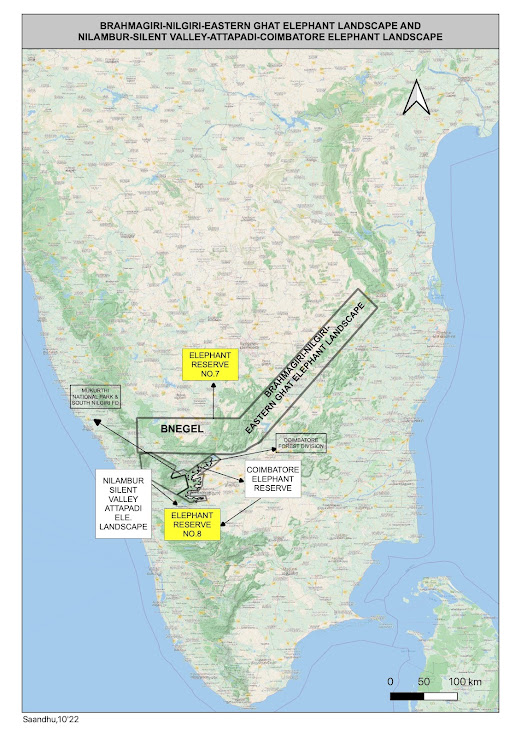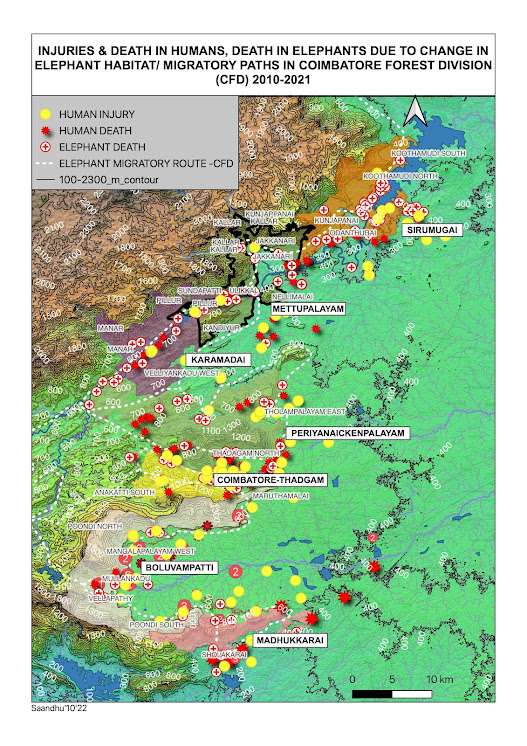Saandhu
14/10/2022
The Asian Elephant is the ultimate flagship species for conservation. Government of India mooted the Project Elephant in 1992 to conserve them, their habitat and the biodiversity contained within by setting up 10 Elephant Reserves in the country. Out of these 10 Reserves, 4 (Reserve 7 to 10) are located in South India. They have a population of 9,500-16,500. The total estimated population in India is 22,000 - 28,000. These designated elephant reserves comprise several forest administrative units with varying conservation priorities and management practices.
Elephant Reserve No.7 extends from the Brahmagiri hills of Karnataka in the North to Nilgiris in the South and to Eastern Ghats in the East. It is thus named Brahmagiri-Nilgiri-Eastern Ghats Landscape. This is said to possess the largest elephant population in Asia. Having an area of 12000 sq.km, it is the home for 6300 elephants.
Elephant Reserve No.8 extends from Nilambur plains of Kerala in the North West to New Ambarambalam Reserve Forest, Silent Valley National Park and the Attapadi Reserve Forest of Kerala in the South West and extend into the Coimbatore Forest Division in the East. Thus Reserve is known as the Nilambur-Silent Valley-Coimbatore Elephant Landscape. This is said to possess an area of 2385 sq.km with an elephant population of 956 - 1208. Most of this reserve, consists of steep hills, cliffs and valleys with very little flat land.
Coimbatore Forest Division acts as the link between these two Elephant Landscapes, facilitating the movement between these two reserves and thus maintaining the gene flow between them.
Coimbatore Forest Division along with Mukurthi National Park and Nilgiri South Forest Division was notified as Coimbatore Elephant Reserve by the Tamil Nadu Government on 19.9.2003. Having an area of 566 sq.km, it is said to be the home for about 329 elephants.
A 2010 study by the Project Elephant Group underlined the importance of notifying the elephant migratory paths between Singara and Masinagudi, Masinagudi to Moyar as an Elephant Corridor to conserve the Brahmagiri-Nilgiri population. Similarly , it underlined the importance of declaring the migratory paths in Kallar and Anaikatti-Veerapandi areas as Corridors. These two areas are located in the Coimbatore Forest Division.
Tamil Nadu Government had notified the migratory pathway between Singara and Moyar as the Sigur Corridor in 2010. The Hon’ble Madras High Court and the Supreme Courts upheld this decision and a ban on all developmental activities in the Corridor was imposed. Resorts located in this area were closed down. This has helped the elephants hugely ever since.
Even though Tamil Nadu Government is yet to notify the migratory path in the Kallar area of Coimbatore Forest Division as an Elephant Corridor, it has notified 50 hectares of land around as private forest, hoping to facilitate the migration of elephants a little further. Whether this act would decrease the number of deaths due to the agitated, rebuffed elephants from the obstructed Kallar Corridor attacking the humans around Odanthurai, only time would tell.
However, the number of humans dyeing and getting injured from the agitated elephants in Thadagam Valley has almost come to an end, even before the Veerapandi-Anaikatti Corridor is notified and secured legally by the Government. The Order of the Hon’ble Madras High Court on 10.2.2021 to close down and seal the 200 illegal brick kilns operating in the Valley for almost two decades was implemented by the District Administration on 19.3.2021. Since then not one human individual has died over the period of the past 18 months. Before this closure, Thadagam Valley used to have the second largest number of deaths and injuries to humans by agitated elephants in Coimbatore Forest Division. Only Boluvampatti Range used to surpass it.
The operators of the illegal brick kilns, however, have not remained silent after the Hon’ble Madras High Court Order. They have spread their operations to new areas again illegally, in the Coimbatore Forest Division itself. They have moved their illegal, highly mechanised operations to the Human Elephant Conflict ridden Mavuthanpathy of Madukkarai Range, Pooluvapatti, Thenkarai, Madhampatti, Vadivelampalayam of the Boluvampatti Range of Coimbatore Forest Division. They have also occupied and almost destroyed Govanur and Tholampalayam Valleys. The total number of brick kilns in the Coimbatore Forest Division is about 350.
These Valley lands do not have a free moving space for elephants. Thadagam Reserve Forest hardly has a low land section through which the pachyderm can move around without any disturbance. Revenue lands extend till the foot hills, beyond which the hills raise abruptly with a very steep slope, making them unsuitable for elephant movement. This forces the elephants to use either the Patta Lands or the dry stream beds of the Valley for their movement. However, the dry stream beds are the only way through which the Brick mud quarries can be reached by the tipper lorries. The direct conflict between the elephants and these tipper lorries agitate the elephants. They in turn kill and injure humans. When this competition ended in Thadagam Valley, human deaths from elephant attack stopped.
The hugely dug up quarries on the elephant migratory paths and stream beds have made migration of elephants very difficult in Thadagam Valley. Elephants using the dry stream bed as their migratory paths were attacked by heavy machinery of the illegal brick kiln operators making them remain eternally agitated. The same experiment is now being repeated in the other Valleys of Coimbatore Forest Division, again illegally.
These illegal brick kilns and their quarries in the other Valleys will increase Human Elephant Conflict exponentially in the near future.
This needs to be stopped.
Nilambur - Silent Valley elephant population will not be able to mix with the Brahmagiri-Nilgiri_Eastern Ghat elephant population when the illegal brick operators of the Coimbatore Forest Division permanently destroy the elephant migratory pathways and streams of this Forest Division.
An ecological catastrophe is on the horizon.
To stop this:
- All Brick Kiln activity should be banned for 2 kilometers from the foot hills of Western Ghats. Forest Department has proposed this already.
- This zone should be notified as Eco-Sensitive Zone,
- The illegal brick kiln operators should be made to pay the compensation for all the damages caused to the elephant migratory paths.
- Criminal proceedings should be mounted on all these illegal operators. This alone would deter them in future from going to new places and causing permanent destruction of the land and water bodies.





Comments
Post a Comment